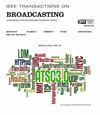Distortion Propagation Factor Estimation for VVC Low-Delay Hierarchical Coding
IF 4.8
1区 计算机科学
Q2 ENGINEERING, ELECTRICAL & ELECTRONIC
引用次数: 0
Abstract
Previous studies have shown that temporally dependent rate-distortion optimization (RDO) methods can enhance the compression performance of video encoders. However, accurately quantifying temporal rate-distortion dependencies in the latest video coding standard, Versatile Video Coding (VVC), remains a significant challenge. To address this issue, this paper proposes a distortion propagation factor (DPF) estimation method tailored for VVC low-delay hierarchical coding, aiming to achieve temporally dependent RDO. Specifically, we first derive a formula for calculating the DPF based on coding distortion and motion-compensated prediction (MCP) errors. Building on this, we present several pre-encoding-based DPF estimation schemes designed for the VVC low-delay hierarchical coding structure. These schemes have very low computational complexity and do not require buffering subsequent unencoded frames for pre-analysis, thereby avoiding additional encoding delays. Finally, the estimated DPFs are used to adaptively adjust the Lagrange multipliers and quantization parameters of each coding tree unit, optimizing the allocation of coding bit resources. After integrating the proposed method into the VVC test model VTM-23.0, experimental results show that one of the proposed DPF estimation schemes achieves average bit rate savings of 4.25% for low-delay B slices and 4.12% for low-delay P slices, with only a 1% increase in computational complexity. The proposed method offers an effective solution for enhancing the compression performance of VVC encoders. Consequently, the proposed DPF estimation approaches have already been adopted by the Joint Video Experts Team (JVET) and officially integrated into the VVC reference software.VVC低延迟分层编码的失真传播因子估计
已有研究表明,时变率失真优化(RDO)方法可以提高视频编码器的压缩性能。然而,在最新的视频编码标准——通用视频编码(VVC)中,准确量化时间率失真依赖关系仍然是一个重大挑战。为了解决这一问题,本文提出了一种针对VVC低延迟分层编码的失真传播因子(DPF)估计方法,旨在实现时间相关的RDO。具体来说,我们首先推导了基于编码失真和运动补偿预测(MCP)误差的DPF计算公式。在此基础上,针对VVC低延迟分层编码结构,提出了几种基于预编码的DPF估计方案。这些方案具有非常低的计算复杂度,并且不需要缓冲后续的未编码帧进行预分析,从而避免了额外的编码延迟。最后,利用估计的dpf自适应调整每个编码树单元的拉格朗日乘子和量化参数,优化编码位资源的分配。将该方法与VVC测试模型VTM-23.0集成后,实验结果表明,其中一种DPF估计方案在低延迟B片和低延迟P片上平均比特率分别节省4.25%和4.12%,而计算复杂度仅增加1%。该方法为提高VVC编码器的压缩性能提供了一种有效的解决方案。因此,提出的DPF估计方法已被联合视频专家组(JVET)采用,并正式集成到VVC参考软件中。
本文章由计算机程序翻译,如有差异,请以英文原文为准。
求助全文
约1分钟内获得全文
求助全文
来源期刊

IEEE Transactions on Broadcasting
工程技术-电信学
CiteScore
9.40
自引率
31.10%
发文量
79
审稿时长
6-12 weeks
期刊介绍:
The Society’s Field of Interest is “Devices, equipment, techniques and systems related to broadcast technology, including the production, distribution, transmission, and propagation aspects.” In addition to this formal FOI statement, which is used to provide guidance to the Publications Committee in the selection of content, the AdCom has further resolved that “broadcast systems includes all aspects of transmission, propagation, and reception.”
 求助内容:
求助内容: 应助结果提醒方式:
应助结果提醒方式:


